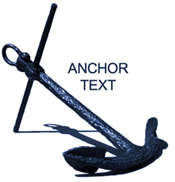 When it comes to SEO, people usually associate links with “external” links – outside sites linked back to your site. However, internal links – text links pointing back to content within your website – are just as important when it comes to optimization. However, if you don’t utilize internal links and anchor text correctly, you could jeopardize your site’s optimization potential.
When it comes to SEO, people usually associate links with “external” links – outside sites linked back to your site. However, internal links – text links pointing back to content within your website – are just as important when it comes to optimization. However, if you don’t utilize internal links and anchor text correctly, you could jeopardize your site’s optimization potential.
Using the Right Anchor Text
 Anchor text is the hyperlinked word or phrases that describe that page to search engines.
Anchor text is the hyperlinked word or phrases that describe that page to search engines.
For example, you wouldn’t want to use “click now” as part of your anchor text. You are telling search engines that your subject is about “click now.”
Steer clear of using irrelevant words in your anchor text. This will mess up your SEO. If you use the anchor text “Internet marketing tools,” search engines recognize that the page is about “Internet marketing tools.” The words in the anchor text determine the ranking that target page will receive by search engines. “Click now” isn’t going to help your rankings at all – you want “Internet marketing tools” to be ranked NOT “click now.”
Dos and Don’ts of Internal Linking
 When it comes to internal links, keep it simple. Don’t create LONG sentence links to pages on your home and product pages. This will definitely decrease your link effectiveness (not to mention your site visitors will become annoyed!)
When it comes to internal links, keep it simple. Don’t create LONG sentence links to pages on your home and product pages. This will definitely decrease your link effectiveness (not to mention your site visitors will become annoyed!)
Links from home pages should be limited to top pages your want to market to visitors. Think strategically. Your home page is the page linked to the most (or has the highest PR) than other pages on your site.
The Importance of Keywords
 Whether it’s an internal link or anchor text, it all comes down to the importance of keywords. Internal linking needs to contain keywords/phrases which clearly explain what’s on the page and who exactly you’re trying to market.
Whether it’s an internal link or anchor text, it all comes down to the importance of keywords. Internal linking needs to contain keywords/phrases which clearly explain what’s on the page and who exactly you’re trying to market.
• Home Pages – If you are an e-commerce site that sells wine-related products, a button titled, “Products We Sell” isn’t going to rank well in the search engines. A better example: “Wine-R-Us Inc. Corkscrews” You are more likely to be found in the SERPS because your button is now a keyword-rich link. Remember to take into account keywords and how many links you use on your navigational menu.
• Navigational Menus – Take into consideration how many links you plan to use for your navigational menus. Remember to use keyword-effective links. Remember to include navigational menus on home pages and sub pages.
• Sub Pages – You also need to link from within sub pages (not just the home page). Make sure that links contain the appropriate keywords. If you sell products/services, you need to add a list of “Related Products/Services” on each product/services page. This will help build your internal links.
• Keyword Research – If you’re a novice to SEO and internal linking, utilize keyword research tools such as Google AdWords and WordTracker. Choose words with a high number of people searching for those words. You need to find a balance – find a combination of keywords that are in high demand without HUGE competition either. You want to attract high rankings in SERPs.

